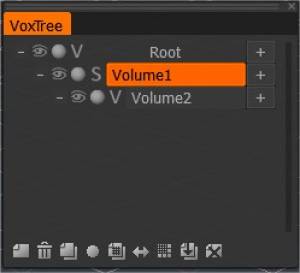Μπορείτε να σύρετε και να αποθέσετε επίπεδα για να κάνετε πολλά πράγματα, όπως να μετακινήσετε ένα επίπεδο στον κάδο απορριμμάτων, να δημιουργήσετε εκ νέου γονέα σύροντας σε ένα σύμβολο επίπεδα + ή απλώς απλώς να αναδιατάξετε τα επίπεδα για να τα οργανώσετε. Ας το περάσουμε από πάνω προς τα κάτω.

Root: Αυτό είναι το βασικό αρχείο ή σκηνή σας. Δεν μπορείτε να το επεξεργαστείτε αυτό.
– (Σύμπτυξη θυγατρικών επιπέδων): Το μείον δίπλα σε οποιοδήποτε επίπεδο θα σας επιτρέψει να συμπτύξετε τυχόν θυγατρικά επίπεδα που μπορεί να έχει.
Ορατότητα: Κάνοντας κλικ στο «βολβό του ματιού», μπορείτε να ενεργοποιήσετε ή να απενεργοποιήσετε την ορατότητα ενός στρώματος.
Λειτουργία Ghost: Ενεργοποιήστε/απενεργοποιήστε τη λειτουργία ghost και η ένταση θα γίνει μισοδιαφανής και δεν θα επιλέγεται. Θα προστατεύεται επίσης για επεξεργασία.
V και S: Αυτά τα εικονίδια εναλλάσσονται μεταξύ της λειτουργίας έντασης ήχου και της λειτουργίας επιφάνειας.
+ (Προσθήκη επιπέδου): Το συν δίπλα σε οποιοδήποτε επίπεδο θα προσθέσει ένα νέο επίπεδο γονικό στο επίπεδο στο οποίο κάνατε κλικ στο εικονίδιο δίπλα. Εάν προσθέσετε ένα στρώμα στη ρίζα, δεν θα έχει γονέα.
Όνομα επιπέδου: Κάθε επίπεδο αντιπροσωπεύεται με μια οριζόντια γραμμή. Κάνοντας διπλό κλικ στη γραμμή, μπορείτε να αλλάξετε το όνομα.
Ανάλυση επιπέδου: Θα παρατηρήσετε ότι εάν έχετε αλλάξει την ανάλυση ενός επιπέδου, πριν εμφανιστεί το όνομα του επιπέδου, ένας αριθμός που το αντιπροσωπεύει, για παράδειγμα, ως [2x], [4x] και ούτω καθεξής.
– Κάντε κλικ στο Υποβάθμιση/Επαναφορά δεν θα αποθηκεύσει/αποθηκεύσει την προσωρινή μνήμη αμέσως για να αποφύγετε ανεπιθύμητες ενέργειες.
Εικονίδια στο κάτω μέρος
Τώρα για τα εικονίδια στο κάτω μέρος του VoxTree, από αριστερά:
Κενή σημείωση: Δημιουργεί ένα νέο επίπεδο γονικό στη ρίζα.
Κάδος απορριμμάτων: Αυτό θα διαγράψει το τρέχον επιλεγμένο επίπεδο.
2 κενές σημειώσεις: Αυτό θα αντιγράψει το τρέχον επιλεγμένο επίπεδο.
Ball: Επεξεργαστείτε τις ιδιότητες shader του τρέχοντος επιλεγμένου στρώματος.
2 κενές σημειώσεις με πλέγμα: Θα αντιγράψουν τις ρυθμίσεις ανάλυσης και μετασχηματισμού του τρέχοντος επιλεγμένου επιπέδου. Τίποτα άλλο δεν θα επαναληφθεί. Αυτή είναι μια εξαιρετική λειτουργία για όταν θέλετε να έχετε ένα άλλο επίπεδο με τις ίδιες ρυθμίσεις αλλά όχι τα voxel.
Βέλη διπλής όψης: Αυτό το εικονίδιο προορίζεται για το εργαλείο αντιγραφής συμμετρίας. Εάν έχετε σμιλέψει στη μία πλευρά ενός αντικειμένου όγκου, μπορείτε να χρησιμοποιήσετε αυτό το εικονίδιο για να αντιγράψετε όλα αυτά στην άλλη πλευρά του αντικειμένου. Λειτουργεί σε οποιονδήποτε άξονα, αρκεί να έχετε ενεργοποιημένη τη συμμετρία κατά μήκος του προτιμώμενου άξονα.
Πλέγμα: Αυτό το εικονίδιο θα αυξήσει την ανάλυση.
Σημείωση κάτω βέλους: Αυτό το εικονίδιο θα αντιγράψει και θα μειώσει την ανάλυση (κατά 2x) του επιλεγμένου επιπέδου σας.
Αυτό είναι βολικό εάν έχετε ένα στρώμα αντικειμένου με πολύ υψηλή ανάλυση και πρέπει να το αφαιρέσετε για κάποια επεξεργασία.
Προσέξτε ότι θα χάσετε λεπτομέρειες αν γίνει αυτό.
X-note: Αυτό θα καθαρίσει το επιλεγμένο επίπεδο αντικειμένου στο VoxTree από τυχόν voxel. Λειτουργεί όπως το εργαλείο “Εκκαθάριση” στην αριστερή πλευρική γραμμή εργαλείων στην ενότητα Εντολές.
Φροντιστήρια
Βελτιώσεις επιλογής επιπέδου : Αυτό το βίντεο καλύπτει μερικά κρυφά πετράδια που σχετίζονται με τη γρήγορη επιλογή ενός επιπέδου/αντικειμένου στο παράθυρο προβολής, την απομόνωση (ορατότητα) ενός επιπέδου και την επακόλουθη αποκατάσταση κρυφών τόμων.
Επεξεργασία μεμονωμένων τμημάτων ενός επιπέδου SculptTree : Αυτό το βίντεο προσφέρει μια γρήγορη συμβουλή σχετικά με τον χειρισμό μεμονωμένων τμημάτων ενός στρώματος SculptTree (στον χώρο εργασίας Sculpt) ή τον διαχωρισμό τους σε ξεχωριστά θυγατρικά επίπεδα.
Vox Tree Layer Multi-Select : Αυτό το βίντεο δείχνει τη χρήση της Πολλαπλής Επιλογής σχετικά με τα επίπεδα VoxTree, η οποία επιτρέπει πλέον περισσότερες λειτουργίες, συμπεριλαμβανομένης της διαγραφής επιπέδων και των επιλογών Global Space.
Multi-Select VoxTree Layers : Αυτό το βίντεο δείχνει τη χρήση της Multi-Selection σχετικά με τα επίπεδα VoxTree, η οποία επιτρέπει πλέον περισσότερες λειτουργίες, συμπεριλαμβανομένης της διαγραφής επιπέδων και των επιλογών Global Space.
 Ελληνικά
Ελληνικά  English
English Українська
Українська Español
Español Deutsch
Deutsch Français
Français 日本語
日本語 Русский
Русский 한국어
한국어 Polski
Polski 中文 (中国)
中文 (中国) Português
Português Italiano
Italiano Suomi
Suomi Svenska
Svenska 中文 (台灣)
中文 (台灣) Dansk
Dansk Slovenčina
Slovenčina Türkçe
Türkçe Nederlands
Nederlands Magyar
Magyar ไทย
ไทย हिन्दी
हिन्दी Tiếng Việt
Tiếng Việt Lietuviškai
Lietuviškai Latviešu valoda
Latviešu valoda Eesti
Eesti Čeština
Čeština Română
Română Norsk Bokmål
Norsk Bokmål